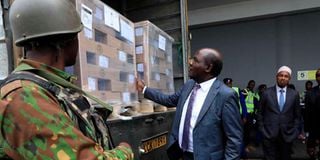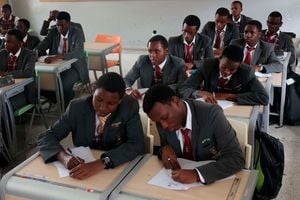The making of an opaque Kenyan election

IEBC Chairperson Wafula Chebukati.
The electoral commission is on the spot over lack of transparency in its preparations for the August 9 General Election as key polling data and information is not available to stakeholders and the media.
Nobody knows the number and locations of new polling stations, facts about the results transmission path and the circumstances surrounding the abandonment of text data to guarantee livestreaming.
There are also questions over due diligence done on the company providing the elections technology, and failure to make public a voter register audit report, two months after it was finalised.
In 2017, the Independent Electoral and Boundaries Commission broke down data on the 40,883 polling stations per counties, constituencies, and wards. This year, however, it has listed 46,233 stations without indicating how they are distributed, making it difficult to assess where the additional one are located.
IEBC says it will use photographs of results declaration forms, rather than alphanumeric data of the results, as their primary data source. This could delay real-time transmission as it will have to manually key in results from tens of thousands of photographs of forms shared by returning officers.
“Uchaguzi Platform is concerned about the management and transmission of election results, as well as testing of the requisite election technology, now that we are well past the statutory timelines of such an exercise. The country cannot afford another systematic failure, as witnessed in the first simulation exercise on June 9, as there is no time to undertake another simulation without completely eroding trust in the systems,” it said in a statement that was also signed by other election observation groups, monitors, civil and human rights lobbies.
“The country is still not properly informed about the procurement, testing, and functionality of the strategic technologies to be used in the elections,” they added.
On technology, they observed: “The country does not know whether the commission undertook an audit of the existing kits before purchasing any new ones and, if it did, why the report has not been made public.”
The commission has invited the media to be part of the tallying and transmission process, but the omission of alphanumeric data might mean difficulty in relaying them. In 2017, the data, as relayed by IEBC officers, was displayed on big screens, with Kenyans simultaneously allowed to download images of the results declaration forms.
Tally centres
“Results at polling stations are final. The commission will only declare the winner but the results are not the preserve of the commission,” IEBC Chairman Wafula Chebukati said recently. “The media will have access to the results both at the tallying centres and at the polling stations. So let candidates, agents and media get copies of the results,” he added.

Independent Electoral and Boundaries Commission Chairman Wafula Chebukati leads his team in receiving the first batch of ballot papers at the Jomo Kenyatta International Airport on July 7.
The lobbies want IEBC to release the voter audit report that was done by KPMG. “Without a credible register, it is difficult to assess the quality or honesty of elections,” they said.
But what is even more concerning is the commission’s shock admission of having failed to unearth the dark past of Smartmatic International before awarding the firm a multibillion-shilling voter identification and results transmission contract.
Responding to questions on whether IEBC’s secretariat did due diligence before awarding the Sh4 billion tender to the Dutch firm, IEBC chief executive Marjan Hussein Marjan admitted that the controversial past of the company in past polls did not come to their attention. He said the revelations surrounding the history of the company, which supplied the Kenya Integrated Elections Management System (Kiems) kits, were never cited during the evaluation process, putting into question the integrity of the procurement process.
“I relied on the evaluation committee’s report after they did their due diligence. This information did not even come to our attention. It would require the company to respond. I don’t have the answers,” he said.
But this assertion contradicts his earlier statement that the procurement process was above board. That due diligence was done, involving going to places where Smartmatic carried out elections before, interviewing officials in the said countries as well as visiting their headquarters.
“I think it would be proper if these questions could be directed to the company. I cannot speak on their behalf,” he said.
Smartmatic International has a controversial track record that has seen multiple countries question the reliability of its technology.
From the US to Venezuela, Zambia, Uganda and the Philippines, the company’s reputation has taken a hit amid accusations of tender irregularities and provision of kits that are vulnerable to tampering.
Its contract involves the supply of up to 10,000 Kiems kits for use in the polls as well as building and implementing electronic voter systems. It is also the software provider for the kits, having replaced OT Morpho, now called Idemia, which was the technology service provider for IEBC in 2017.
In Venezuela in 2017, Smartmatic acknowledged that turnout voter figures were manipulated by at least a million. In Uganda, the biometric voter kits failed in 2020, forcing election officials to revert to the manual system.
Failures and irregularities of the voting system in the Philippines were cited by some candidates for their failure to win. Their country’s cyber unit confirmed the allegations after an investigation.
An article in The Manila Times published on January 31 stated that a government agency, Cybercrime Investigation and Coordinating Centre, concluded that Smartmatic “is compromised” following the 2016 elections.
In the US, Smartmatic provided election technology in one county during the 2020 polls but faced questions over its technology and software in the aftermath of the hotly contested presidential elections. The company has, however, strongly defended itself against the accusations, claiming allegations made against it are false and intended to injure its reputation.
Nevertheless, the contract award to Smartmatic had been challenged at the Public Procurement Administrative Review Board (PPARB), which had nullified it following an appeal by Risk Africa Innovatis Limited. However, the High Court allowed IEBC to award the contract to Smartmatic.
Risk Africa Innovatis was part of companies that bid for the IEBC technology tender besides Indra Soluciones Tecnologias De La Informacion, Genkey Solutions BV, Laxton Group Ltd and Africa Infrastructure Development Company.
Their argument was that IEBC had not been fully constituted during the time it was conducting the procurement, and that data migration was not budgeted for at the time the tender was being floated.
On the polling stations, the Nation analysed the 46,233 polling stations to see where the 6,000 extra units are. Nairobi got 960 additional stations while the Rift Valley had the most number of new centres per region. The number of voters has risen from 19,611,423 to 22,120,458, equivalent to 12.79 per cent increase. No station should hold more than 700 voters.
Nairobi, which has 2,415,310 voters, got 960 additional stations, increasing its tally to 4,338 from 3,378 in 2017.
The Rift Valley, which has 2,670,969 registered voters, got 949 additional stations, the second highest number. Turkana got 147, West Pokot (145), Uasin Gishu (97), Elgeyo-Marakwet (26), Nandi (134), Baringo (138), Kericho (140), Bomet (123), Samburu (48), Narok (132) and Kajiado (91).
The three Maa counties, which have been identified as battlegrounds, have 962,071 voters. Mt Kenya, which has 10 counties, got 894 new stations. These are Meru (169), Tharaka-Nithi (46), Embu (37), Nyandarua (71), Nyeri (49), Kirinyaga (38), Murang’a (56), Kiambu (157), Laikipia (31) and Nakuru (242). They have a total of 5,131,963 voters.
In Nyanza, the six counties with 3,120,732 voters got 802 additional stations. In 2017, the region had 5,510 stations, now it has 6,312.
In Ukambani, there 355 additional stations. They are Kitui (129), Machakos (151) and Makueni (75). In 2017, the region had 3,846 stations, now it has 4,201.
The three counties in the Lower Eastern region have 1,699,724 registered votes.
Counties in North Eastern region got more additional stations than those in Coast. The five counties of North Eastern have 882,677 voters and got 591 additional stations. They are Garissa (178), Wajir (175), Mandera (153), Marsabit (63) and Isiolo (22).
The six counties of Coast have 1,963,144 voters and were given an additional 517 stations. They are Mombasa (111), Kwale (131), Kilifi (154), Tana River (58), Lamu (22) and Taita Taveta (41).
Presidential candidates William Ruto (United Democratic Alliance), Mr Raila Odinga (Azimio la Umoja One Kenya), Prof George Wajackoyah (Roots Party) and Mr David Mwaure Waihiga (Agano party) will have to recruit over 46,000 agents to take care of their interests in the polling stations.






